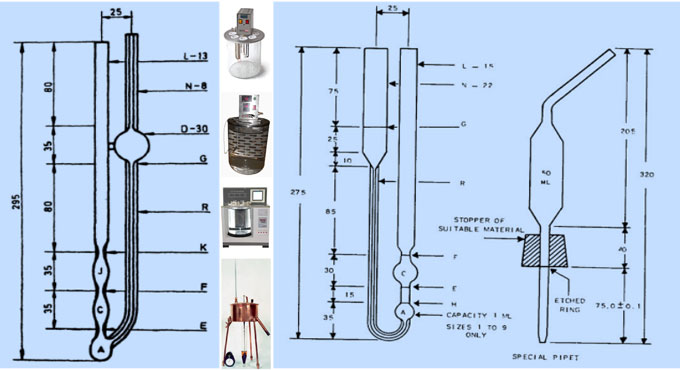
Revealing the Significance of Bitumen Viscosity Tests: An Essential Step towards Excellent Construction

In the realm of construction, the role of bitumen as a binding agent cannot be overstated. This viscous, black substance is a key component in the creation of asphalt, the backbone of our roadways and infrastructure. However, the effectiveness of bitumen lies not only in its presence but also in its quality, which can be assessed through a crucial process known as viscosity testing.
Understanding Viscosity in Bitumen
Viscosity is a measure of a fluid's resistance to flow. In the context of bitumen, viscosity refers to its ability to flow and coat aggregates during the construction of roads and other infrastructure. This property is highly dependent on temperature; as temperature increases, bitumen becomes less viscous, making it more fluid and easier to work with.
Reasons for Viscosity Testing
Quality Control:
Viscosity testing serves as a vital quality control measure in the production of bitumen. The consistency and flow characteristics of bitumen are indicative of its purity and suitability for construction applications. Consistency in viscosity ensures that the bitumen will perform as expected in various weather conditions.
Performance Prediction:
The performance of bituminous materials is heavily influenced by their viscosity. By conducting viscosity tests, engineers and construction professionals can predict how bitumen will behave under different temperature conditions, allowing for the formulation of asphalt mixes that meet specific performance requirements.
Durability Assessment:
The durability of asphalt pavements relies on the ability of bitumen to withstand the stresses imposed by traffic loads, temperature variations, and environmental factors. Viscosity testing helps assess the durability of bitumen, guiding the selection of materials that can withstand the harsh conditions of the construction environment.
The Viscosity Testing Process
The viscosity of bitumen is commonly measured using the Brookfield Viscometer, which determines the resistance of bitumen to flow under controlled temperature and load conditions. The procedure involves the following steps:
Sample Preparation:
Before testing, a representative sample of bitumen is carefully collected, ensuring it accurately reflects the material's properties. This sample is then conditioned to a specific temperature, typically in the range of 135 to 160 degrees Celsius, to simulate the high temperatures encountered during construction.
Viscometer Setup:
The Brookfield Viscometer is a rotational viscometer that measures the torque required to rotate a spindle through a sample at a constant speed. The selected spindle is immersed into the bitumen sample in the viscometer chamber. The viscometer is equipped with a temperature control system to maintain a constant test temperature.
Testing Procedure:
The viscometer spindle is set into motion, and the torque required to rotate the spindle is recorded. This torque value is directly proportional to the viscosity of the bitumen. The test is typically performed at multiple shear rates to capture the rheological behavior of the bitumen under different stress conditions.
Data Analysis:
The recorded torque values are then used to calculate the viscosity of the bitumen at the specified temperature. The resulting data provides valuable insights into the flow behavior of the bitumen and its suitability for construction applications.
Importance of Viscosity Testing in Construction
Optimizing Mix Design:
Viscosity testing plays a pivotal role in asphalt mix design. Engineers use the viscosity data to optimize the composition of asphalt mixes, ensuring that the bitumen adequately coats the aggregates and forms a durable, high-performance pavement.
Temperature Sensitivity:
Understanding the temperature sensitivity of bitumen is crucial in regions with extreme weather conditions. Viscosity testing helps identify the appropriate grade of bitumen for a specific climate, ensuring that the asphalt remains workable during construction and performs reliably over its service life.
Consistent Performance:
Consistency in bitumen properties, as ensured by viscosity testing, contributes to the uniformity of asphalt pavements. This, in turn, results in consistent performance, reduced maintenance requirements, and enhanced safety for road users.
Prolonged Pavement Life:
Pavement distress, such as rutting, cracking, and stripping, is often linked to the properties of the bitumen binder. Viscosity testing aids in the selection of bitumen with optimal rheological properties, contributing to the longevity and structural integrity of the pavement.
Economic Considerations:
Accurate viscosity testing allows for the selection of bitumen grades that balance performance requirements with economic considerations. By choosing the right bitumen for specific applications, construction projects can achieve cost-effectiveness without compromising quality.
Challenges in Viscosity Testing
While viscosity testing is a powerful tool in ensuring the quality of bitumen, it is not without its challenges. Some of the common issues include:
Temperature Sensitivity:
Achieving and maintaining the required test temperatures can be challenging, particularly in field conditions. The accuracy of viscosity measurements is highly dependent on precise temperature control, and deviations can lead to inaccurate results.
Sample Homogeneity:
The consistency of bitumen samples is critical for obtaining reliable viscosity data. Variations in sample homogeneity can introduce errors in the test results, emphasizing the importance of proper sample preparation techniques.
To learn more, watch the following video tutorial.
Video Source: Infinity Galaxy
Equipment Calibration:
Regular calibration of viscometers is essential to ensure accurate and repeatable results. Failure to calibrate equipment regularly can lead to erroneous measurements, impacting the reliability of viscosity data.
Time Constraints:
In construction projects where time is of the essence, waiting for viscosity test results can be a challenge. Rapid field tests are being developed to address this issue, allowing for quicker assessments without compromising accuracy.
Conclusion
In the intricate tapestry of construction, bitumen stands as a linchpin, binding together the elements of roads and infrastructure. The viscosity test emerges as a guardian of quality, offering insights into the behavior of bitumen under various conditions. Through meticulous testing and analysis, construction professionals can craft pavements that withstand the test of time and traffic.
As we navigate the ever-evolving landscape of construction technology, it is imperative to continue refining and advancing viscosity testing methods. By doing so, we fortify our ability to construct resilient, sustainable, and high-performance infrastructure, laying the foundation for a connected and mobile future.


